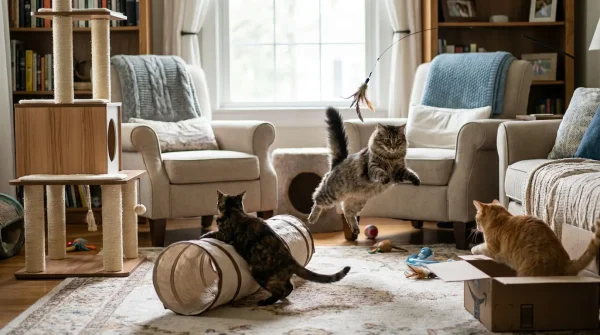Common Cat Behavior Problems Solved: Expert Guide for Irish Cat Owners
Understanding Cat Behavior Problems: A Complete Guide
Cats are wonderful companions, but sometimes their natural instincts and behaviors can create challenges. From inappropriate urination to aggressive scratching, cat behavior problems can strain the bond between you and your feline friend. This comprehensive guide explores the most common cat behavior issues and provides proven, veterinary-approved solutions.
Most Common Cat Behavior Problems
1. Inappropriate Urination and Spraying
The Problem: Your cat is urinating outside the litter box or spraying on vertical surfaces.
Why It Happens:
- Medical issues: Urinary tract infections, kidney disease, or diabetes
- Litter box problems: Dirty box, wrong litter type, or inadequate number of boxes
- Stress and anxiety: Changes in environment or new pets
- Territorial marking: Unneutered males marking territory
Solutions That Work:
- Vet check first: Rule out medical causes immediately
- Optimize the litter box: Use unscented clumping litter, scoop daily, and provide one box per cat plus one extra
- Clean thoroughly: Use enzymatic cleaners to eliminate odors
- Reduce stress: Provide vertical spaces and maintain consistent routines
2. Destructive Scratching
The Problem: Your cat is scratching furniture, carpets, or door frames.
Why It Happens: Scratching is natural for cats to mark territory, stretch muscles, and maintain claw health.
Solutions That Work:
- Provide alternatives: Offer multiple scratching posts (sisal, carpet, and cardboard)
- Position strategically: Place posts near sleeping areas and entry points
- Make furniture unappealing: Use double-sided tape or deterrents temporarily
- Trim claws regularly: Monthly nail trims reduce damage
3. Aggression Toward People or Other Pets
The Problem: Your cat hisses, swats, bites, or shows other aggressive behaviors.
Why It Happens:
- Fear-based aggression: Previous trauma or feeling cornered
- Play aggression: Young cats using teeth and claws inappropriately during play
- Petting-induced aggression: Overstimulation from too much petting
- Pain-induced: Underlying medical conditions causing irritability
Solutions That Work:
- Never punish: Punishment increases fear and worsens aggression
- Identify triggers: Keep a behavior diary to spot patterns
- Provide safe spaces: Ensure your cat has escape routes and high perches
- Enrich the environment: Increase play sessions with interactive toys
- Consult professionals: Severe cases may need a veterinary behaviorist
4. Excessive Meowing or Vocalization
The Problem: Your cat meows constantly, especially at night.
Why It Happens:
- Attention-seeking: Learned that meowing gets a response
- Cognitive dysfunction: Senior cats may vocalize from confusion
- Medical issues: Hyperthyroidism, high blood pressure, or pain
Solutions That Work:
- Vet examination: Essential for ruling out medical causes
- Don’t reward the behavior: Ignore attention-seeking meowing
- Establish routines: Feed at consistent times and provide pre-bedtime play
- Enrich the environment: Puzzle feeders keep cats occupied
Medical Causes of Behavior Problems
Many behavior issues have underlying medical causes. Always rule out health problems first.
Common medical issues that manifest as behavior problems:
- Urinary tract disease: Pain causing litter box avoidance
- Arthritis: Pain making it hard to access litter boxes
- Dental disease: Oral pain leading to aggression
- Hyperthyroidism: Causing increased vocalization
- Cognitive dysfunction: Senior cat confusion and anxiety
Environmental Enrichment: Prevention is Key
The best approach is prevention through proper environmental enrichment:
Essential Enrichment:
1. Vertical Territory
Provide cat trees, wall-mounted shelves, or window perches. Cats feel secure with elevated vantage points.
2. Interactive Play
Schedule 2-3 short play sessions daily (10-15 minutes) with wand toys that mimic prey movement.
3. Puzzle Feeders
Make mealtime mentally stimulating with food puzzles.
4. Safe Outdoor Access
Consider a catio or leash training for supervised outdoor time.
5. Multiple Resources
In multi-cat homes, provide multiple food stations, water bowls, litter boxes, and scratching posts.
When to Seek Professional Help
Consult professionals for:
- Severe aggression (bites breaking skin)
- Persistent elimination problems
- Self-harm from excessive grooming
- Senior cat behavioral changes
Creating a Cat-Friendly Irish Home
Weather-Related Considerations:
- Damp conditions: Ensure litter boxes stay dry and away from drafts
- Colder months: Provide warm bedding for senior cats
- Indoor enrichment: Increase interactive play during rainy periods
Final Thoughts: Patience and Understanding
Remember:
- Your cat isn’t misbehaving to upset you—they’re communicating a need
- Most problems have solutions when you identify the underlying cause
- Never hesitate to seek veterinary advice
With these strategies, you can address most common cat behavior problems and strengthen your bond with your feline companion.
Need Help with Cat Behavior Problems?
Visit PetPal.ie for Ireland’s best cat care products including scratching posts, interactive toys, calming aids, and enzymatic cleaners.





